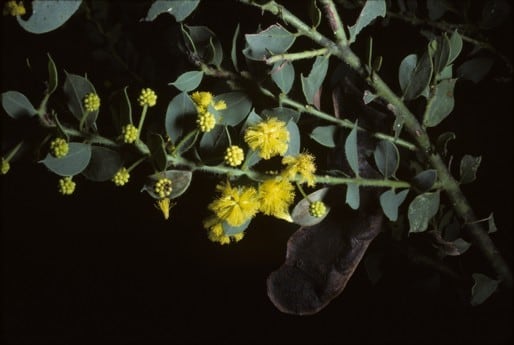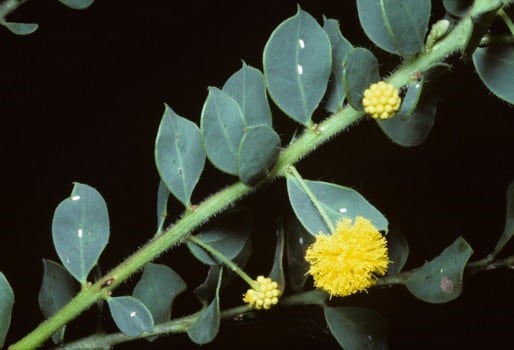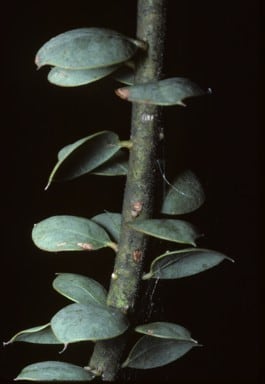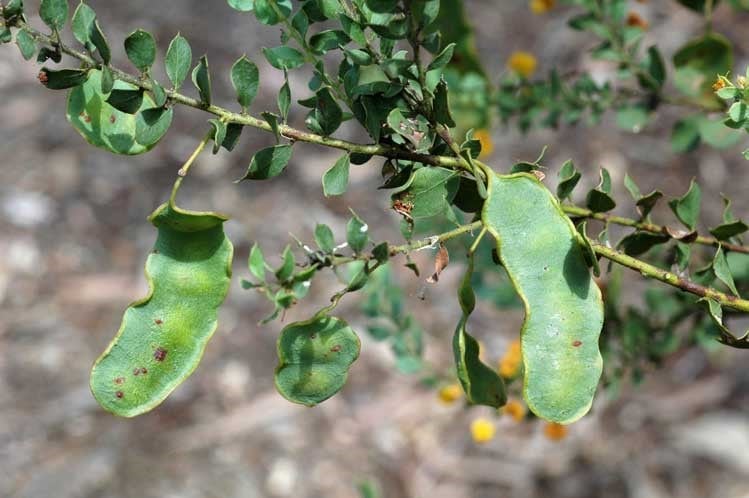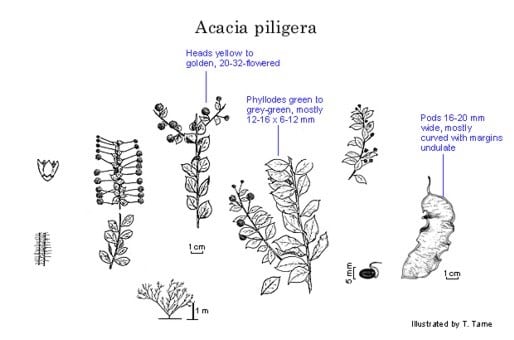Acacia piligera A.Cunn.
WATTLE
Acacias of Australia
Family
Fabaceae
Distribution
Occurring in N.S.W. from the Upper Hunter Valley southwards towards the Hunter Ra.
Description
Obconical open shrub to 1.5–2 m high; branches erect or curving upwards. Branchlets rarely slightly pruinose; glabrous or sparsely hairy. Phyllodes widely spreading and rotated to 45º–75º (–90º) from branchlet or sometimes coplanar, broadly elliptic or sometimes orbicular to broadly obovate, 12–16 (–22) mm long, 6–12 (–15) mm wide, l:w = 1.2–2, grey-green to green, sparsely hairy, sometimes glabrous; base oblique, obtuse or less often acute; margin normally slightly undulate; apex obtuse (mucro uncinate), sometimes acuminate or acute; gland mostly inserted to 3 mm above pulvinus. Inflorescences with patent or inclined peduncles, (6–) 7–11 (–16) mm long, longer than floral phyllodes, 0.4–0.6 mm diam., sparsely hairy or glabrous; heads (7–) 8–9 mm diam., 20–32-flowered, yellow to deep yellow. Corolla glabrous or with few hairs. Pods oblong, mostly curved, 35–80 mm long, 16–20 mm wide, firmly coriaceous, dull dark brown; margin usually undulate, sometimes markedly so.
Habitat
Usually on well-drained stony sandy loams derived from Narrabeen sandstones, in various woodland types, as well as in cleared and disturbed areas.
Specimens
N.S.W.: Scone-Bunnan road, 5.1 km E of Bunnan-Muswellbrook road, B.J.Conn 3810 & T.M.Tame (NSW); 2 km W of Bunnan-Muswellbrook road, on Yarraman Rd, B.J.Conn 3811 & T.M.Tame (NSW); 5.7 km N of Wollar-Bylong road, B.J.Conn 3829 & T.M.Tame (NSW); 5.7 km E of Hollydene, Denman–Sandy Hollow road, T.M.Tame 3798 (NSW); Coxs Gap, Brogedah, NW of Muswellbrook, T.M.Tame 3808 (NSW).
Notes
This is the most morphologically variable species in the ‘A. uncinata group’. In some areas of the Hunter Valley, notably in the Lees Pinch, Merriwa-Gungal and Coxs Gap areas, it is sympatric with A. sertiformis. It may be separated from the latter by its lack of glaucous branchlets and obtuse but not truncate or cordate phyllode bases, and the generally more erect habit, and from all other species in the group by the yellow to dark yellow flowers. Some specimens suggest that hybridisation may occur between this species and A. sertiformis, particularly in the Lees Pinch area.
FOA Reference
Data derived from Flora of Australia Volumes 11A (2001), 11B (2001) and 12 (1998), products of ABRS, ©Commonwealth of Australia
Author
Minor edits by J.Rogers
B.J.Conn, T.M.Tame
This identification key and fact sheets are available as a mobile application:
URL: https://apps.lucidcentral.org/wattle/
© Copyright 2018. All rights reserved.


